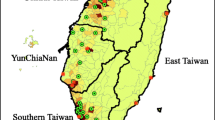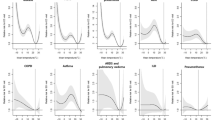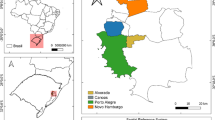Abstract
The southern Brazilian city of Canoas, situated in the metropolitan region of Porto Alegre, is subject to several annual meteorological phenomena, such as cold fronts and squall lines. Here, we assess the relationship between meteorological conditions and outpatient consultations for asthma or bronchitis in children from Canoas City. Data from outpatient consultations of children (below 9 years), between January/2005 and September/2008, were combined with daily meteorological data from 12UTC (morning) and 18UTC (afternoon). We identified 42 days with an excess of outpatient consultations (peaks). Consultations were negatively correlated with temperature and human thermal comfort index (HTCI) from the 3 previous days based on consultation data at 12 and 18UTC, and positively correlated with atmospheric pressure. A positive correlation with relative humidity was significant only at 12UTC. The highest correlations occurred on the day of consultation (12UTC) with temperature, relative humidity, and atmospheric pressure, as well as 2 days previous to the HTCI. The sensation of cold was associated with about 55% of the days of the period at 12UTC: considering only the peaks of consultations, this association exceeds 90% of days. The highest frequencies of respiratory complications (June, July, and August) were associated with negative temperature anomalies, wind speed and direction, and positive anomalies in relative humidity and atmospheric pressure. Nearly half (45%) of the air masses associated with respiratory complications arrived at Canoas from a SW direction, 19% from the south and 14% from the west. In summary, observed increases in respiratory complications were mainly associated with the presence of cold and humid air (and/or falling temperature with increasing humidity) in the morning.







Similar content being viewed by others
References
Azevedo JMF (2010) A influência das variáveis ambientais (meteorológicas e de qualidade do ar) na morbidade respiratória e cardiovascular na Área Metropolitana do Porto. Thesis, University of São Paulo
Bucher K, Haase C (1993) Meteorotropy and medical-meteorological forecasts. Rev Experientia 49:759–768
Coelho MS (2007) Uma análise estatística com vistas a previsibilidade de internações por doenças respiratórias em função de condições meteorotrópicas na cidade de São Paulo. Thesis, University of São Paulo
DATASUS (2016). http://tabnet.datasus.gov.br/cgi/tabcgi.exe?idb2010/d13.def. Accessed 29 december 2016
Draxler RR, Hess GD (1998) An overview of the HYSPLIT_4 modeling system of trajectories, dispersion, and deposition. Aust Meteorol Mag 47:295–308
Fanger PO (1970) Thermal comfort. Analysis and applications in environmental engineering. McGraw-Hill, New York
Givoni B (1976) Man, climate and architecture. Van Nostrand Reinhold Company, London
Gobo JPA, Galvani E (2012) Aplicação do Índice de temperatura efetiva com vento (TEV) nos estudos de conforto térmico para o estado do Rio Grande do Sul. Revista Geonorte 1(5):403–413
Gonçalves FLT, Carvalho LMV, Conde FC, Latorre MRDO, Saldiva PHN, Braga ALF (2005) The effects of air pollution and meteorological parameters on respiratory morbidity during the summer in Sao Paulo city. Environ Int 31:343–349
Hondula DM, Davis RE, Knight DB, Sitka LJ, Enfield K, Gawtry SB, Stenger PJ, Deaton ML, Normile CP, Lee TR (2012) A respiratory alert model for the Shenandoah Valley, Virginia, USA. Int J Biometeorol 57:91–105
Jamason PF, Kalkstein LS, Gergen PJ (1997) A synoptic evaluation of asthma hospital admissions in new York City. Am J Respir Crit Care Med 156:1781–1788
Lecha LB (1998) Biometeorological classification of daily weather types for the humid tropics. Int J Biometeorol 42:77–83
Lopes FN (2015) Associação entre condições meteorológicas de inverno e doenças respiratórias em crianças na cidade de Pelotas-RS. Dissertation, Federal University of Pelotas
Maia JA (2002) Uma análise do conforto térmico e suas relações meteorotrópicas na cidade de São Paulo. Dissertation, University of São Paulo
Martins MCH (2003) Avaliação de interação entre poluição atmosférica e variáveis socioeconômicas como agravantes das condições de saúde no município de São Paulo: um estudo de ecologia humana. Thesis, University of São Paulo
McGregor GR, Walters S, Wordley J (1999) Daily hospital respiratory admissions and winter air mass types, Birmingham, UK. Int J Biometeorol 43:21–30
Monteiro LM (2008) Modelos Preditivos de Conforto Térmico: quantificação de relações entre variáveis microclimáticas e de sensação térmica para avaliação e projeto de espaços abertos. Thesis, University of São Paulo
Nedel AS (2008) Condições meteorológicas favoráveis à ocorrência de doenças respiratórias em crianças da cidade de São Paulo. Thesis, University of São Paulo
Petrou I, Dimitriou K, Kassomenos P (2015) Distinct atmospheric patterns and associations with acute heat-induced mortality in five regions of England. Int J Biometeorol 59:1413–1424
Prietsch SOM, Fischer GB, Cesar JA, Fabris AR, Mehanna H, Ferreira THP, Scheifer LA (2002) Doença aguda das vias aéreas inferiores em menores de cinco anos: influência do ambiente doméstico e do tabagismo materno. J Pediatr 78(5):415–422
Rothfusz LP (1990) The heat index equation (or, more than you ever wanted to know about heat index). National Oceanic and Atmospheric Administration. http://204.227.127.200/images/oun/wxsafety/summerwx/heatindex.pdf. Accessed 03 July 2016
Rusticucci M, Bettolli ML, Harris de Los Angeles M (2002) Association between weather conditions and the number of patients at the emergency room in an Argentine hospital. Int J Biometeorol 46:42–51
Steadman RG (1979) The assessment of sultriness. Part I: a temperature-humidity index based on human physiology and clothing science. J Appl Meteorol 18:861–873
Suping Z, Guanglin M, Yanwen W, Ji L (1992) Study of the relationships between weather conditions and the marathon race, and of meteorotropic effects on distance runners. Int J Biometeorol 36:63–68
VIGIAR (2015). Manual de Instruções. http://portalarquivos2.saude.gov.br/images/pdf/2017/agosto/31/Manual-Unidade-Sentinela-VIGIAR.pdf. Accessed 12 december 2016
Acknowledgments
The authors would like to thank the Instituto Nacional de Meteorologia (INMET) for transferring the meteorological data, the Centro Estadual de Vigilância em Saúde, belonging with the Secretaria da Saúde do Rio Grande do Sul (CEVS/SES/RS) for providing the health data and the Air Resources Laboratory/National Center for Environment Prediction (ARL/NOAA) for making available the HYSPLIT model.
Author information
Authors and Affiliations
Corresponding author
Rights and permissions
About this article
Cite this article
da Silva, I.R., Nedel, A.S., Marques, J.R.Q. et al. Excess of children’s outpatient consultations due to asthma and bronchitis and the association between meteorological variables in Canoas City, Southern Brazil. Int J Biometeorol 63, 1517–1524 (2019). https://doi.org/10.1007/s00484-018-1650-z
Received:
Revised:
Accepted:
Published:
Issue Date:
DOI: https://doi.org/10.1007/s00484-018-1650-z




